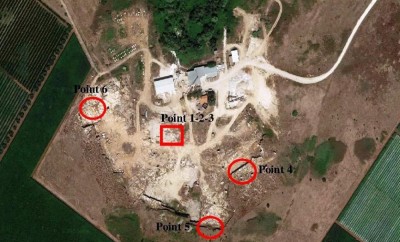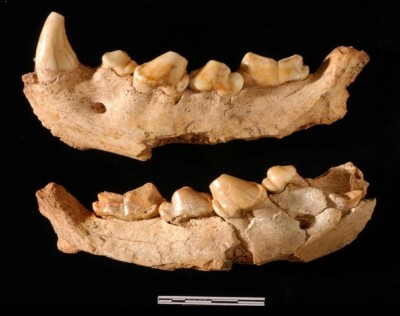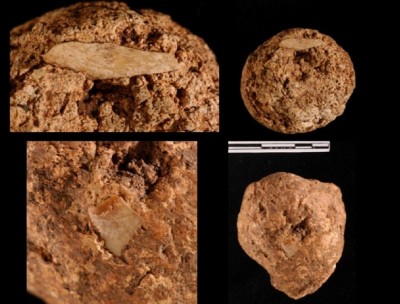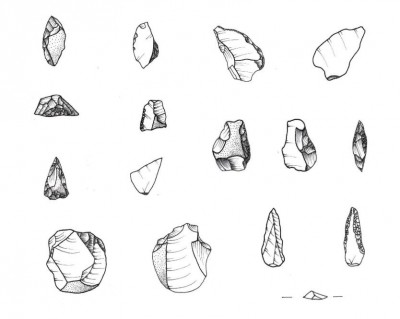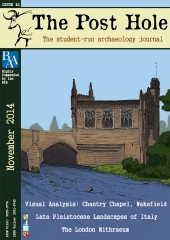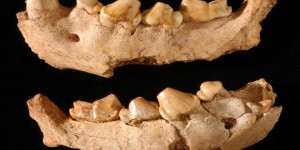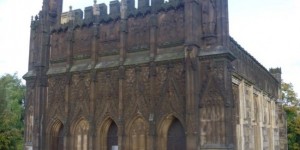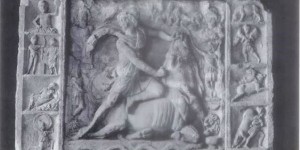Introduction
In recent years environmental studies, applied to archaeological contexts, have seen a growth in importance. This development is mainly thanks to new technologies that allow us to obtain a myriad of data from finds that were once unable to be analysed with the detail possible today. Bioarchaeology, paleoecology and palynology above all have assumed enormous importance as branches of archaeology.
|
Once viewed within the wider archaeological context these studies have allowed us to understand, in some cases, the reason behind the choice of certain territories where humans settle. Here then we have come to understand many new elements concerning the exploitation of land and the human relationship with wildlife, natural resources and mobility strategies. All of this is slowly revolutionizing prehistoric archeology.
Within this framework I am embarking on a PhD to reconstruct the wider landscape of Central Italy during the Late Pleistocene, tackling a region as yet lacking in integrated palaeoecological studies. In this paper I present the findings from Cisterna di Latina (Latina) to demonstrate how my PhD project aims to remedy the situation.
The Late Pleistocene archaeological finds from Cisterna di Latina (Latina)
In July 2012 several faunal bones were delivered to the laboratory of archaeology at Tor Vergata, University of Rome.
Collected by locals from the ground in front of an old quarry face, these finds consisted of several hundred fragmented and barely identifiable bones. However their archaeozoological potential was clear. Initial field surveys confirmed that further material remained in situ and for this reason it was decided to conduct excavation work, with the goal to preserve the integrity of the site and obtain a wide and complete study. In September of the same year fieldwork commenced, coming to an end in March 2014.
Morphologically the site has been confirmed as the front of a quarry, along which appear tens of cracks and cavities of varying sizes. These have been filled by natural sediments and, with high frequency, faunal remains and lithics. The excavation was conducted in six ‘points’ along the current quarry face, positioned in order to maximize the picture of the distribution of archaeological data.
The focus was reserved for “point 3”, from which the initial finds had been recovered. This section along the north side of the Quarry was identified as the bottom of a cavity, almost totally destroyed by quarry works. Despite the small size of the investigable site, approximately 7m², a wide range of information has been collected. It has been possible to reconstruct a stratigraphic sequence and further to observe the distribution of bones inside the cavity, fundamental to the understanding of the site.
In total almost 2,000 bone remains have been examined, identifying the following species:
Mammals:
Equus ferus - Horse (Boddaert 1785)
Stephanorhinus hemitoechus - Rhinoceros (Falconer 1868)|
Bos primigenius - Ox (Bojanus 1827)|
Capreolus capreolus - Roe (Linnaeus 1758)|
Cervus elaphus - Red deer (Linnaeus 1758)
Sus scrofa - Wild boar (Linnaeus 1758)
Crocuta crocuta spelaea - Hyena (Erxleben 1777)
Canis lupus - Wolf (Linnaeus 1758)|
Meles meles - Badger (Linnaeus 1758)
Lepus sp. - Hare|
Arvicola cantianus - Rat (Koenigswald 1973)
A total of 47 coprolites (Fig. 3) were also found, in an excellent state of preservation. These elements have the potential to provide a wealth of information about the archaeological site, such as the presence of certain plant (Callen and Martin 1969) and animal species, but this requires extremely delicate and complex laboratory analysis (Bryant 1974; Horwitz and Goldberg 1989; Reinhard and Bryant Jr. 1992). At present it has been possible to confirm that the coprolites belong to the species Crocuta crocuta spelaea (Hyena).|
Among the materials collected during investigation 52 lithic products have been identified (Fig. 4). The most evident feature of this set is the high number of side-scrapers. Along with the presence of the cortex and the small size of the instruments, these denote the Mousterian lithic type known as “Pontiniano”, typical of the Central Italy Pontine plain (Blanc 1939; Taschini 1972; Bietti and Kuhn 1991; Kuhn 1995).
Discussion
Based on the information provided by the taphonomic record, the main layer of activity at Cisterna di Latina seems to represent a late Pleistocene hyena den dated between 20,000-30,000 BP.
The discovery of this new site and associated artefacts is allowing us the opportunity to make new and more detailed studies, with a particular eye to the paleoenvironmental reconstruction of the site and the surrounding landscape. Such a study will require a full cross-disciplinary analysis in order to gain a complete understanding of the wider picture:
-
Zooarchaeology (for taphonomic and taxonomic studies)
This will enable us to understand the animal habitats from faunal variety, biometric study and sexual dimorphism and may display evidence of evolutionary adaptation to the Pontine plain environment. In turn this will allow a consideration of both the possibilities and restrictions that the environment would have played in hominid existence. Combined with a detailed study of a representative sample of the bones, identifying gnawing, cut and butchering marks, the role that humans played in the wider structure of Palaeolithic ecology may become clearer. -
Paleoecology (for the study of biological remains, plants and most importantly coprolites)
The range of information that we can deduce from this is incredibly large. Just the coprolites analysis alone may divulge information about vertebrate remains, pollen (Bryant 1989), phytoliths, fungus and spores, parasites (Reinhard 1992; Reinhard et al. 1988), seeds and leaf remains, insects, mineral and chemical components that are preserved inside them. Aside from revealing the vegetation of the landscape, elements of diet (Bryant 1986; Callen 1969; Callen and Cameron 1960), nutrition and plant use (Callen and Martin 1969) in the past can all be revealed through a comparison with modern data. -
Lithic analysis
Stone tools and raw materials are not only useful for revealing cultural information and hunting techniques, but more importantly can provide an insight into management strategies, mobility and the choice of land for settlement when places of raw material acquisition are also considered.
The integration of all these different approaches will allow me to paint a broader and more complex picture of human exploitation of the landscape on a regional scale, understanding the reason behind chosen locations and the relationship with fauna, natural resources and mobility strategies.
Although the study is only at the beginning, the archaezoological analysis of the finds has already provided the first interesting results. The evidence suggests the presence of different environments, linked to the morphology of the area surrounding the site which, as at present, varies considerably within a few miles.
Crocuta crocuta spelaea or Canis lupus are an almost ubiquitous species, surviving in a wide range of climates and landscapes, and therefore contribute little towards an environmental reconstruction. Nevertheless, the herbivorous species present can provide a narrower frame. Bos primigenius preferred environments in open pasture but also inhabited wooded areas rich with glades in a temperate climate (Conti et al. 2010; Van Vuure 2002). The presence of the Equus ferus indicates large areas of grassland steppe-plain and a continental climate. A study of the articular surfaces of the distal epiphysis of equine might also suggest that the type of soil present was a soft territory. The presence of cervids attest an open forest environment, whilst the prevalence of Cervus elaphus on Dama dama indicates a largely temperate climate. The absence of goats as Capra ibex and Rupicapra also hints at the absence of extreme weather conditions. Finally the presence of Sus scrofa could indicate the presence of wetlands, which is supported by anthropic works from the middle of the last century that attest to the swampy character of the region.
In summary, the faunal association therefore suggests a mixed environment, with large areas of steppe or prairie alternating with woodland areas characterized by Mediterranean thicket, especially in the hilly area. Along the coastal territory swampy areas are likely to have prevailed. The climate would appear to have been temperate, verging towards slightly cool.
Conclusion and future expectations
As mentioned at the beginning of this brief paper, environmental studies can revolutionize prehistoric archaeology. A knowledge of the surrounding area is of fundamental importance for the understanding of a site and of human interactions with the surrounding area. Although the site under consideration does not demonstrate a sustained human presence it can still provide, as we have seen, the information needed to reconstruct the landscape within which man lived.
The multi-disciplinary model proposed here draws upon different strands of archaeology with the precise aim of reconstructing an environmental context. We have already seen how much information can be gathered for an environmental reconstruction of the Pontine Plain, merely from the faunal analysis of a single site. Other resources have yet to be exploited, including the 47 hyena coprolites. From the diverse archaeological, palaeoecological and archaeozoological perspective, a wide range of forthcoming information could complete the picture of the site and lay the foundation for understanding the wider context of the region.
The site and the material found are of major scientific interest, offering a vast new database upon which to reflect and from which to draw inspiration to improve our knowledge of the area in the Late Pleistocene.
Whilst so much has already been accomplished, these findings represent the beginnings of a much larger project. A great deal of work is still to be done so that we can claim to have a complete picture of the environmental context of the Pontine Plain in the Late Pleistocene. The approach I have outlined should now be applied to a number of sites covering the area as widely as possible, not least to those sites that were excavated in the past when the analysis available was insufficient in comparison to what is possible today.
Acknowledgments
|
A special thanks is given to my supervisor at the University of Rome - Tor Vergata, Professor Mario F. Rolfo, and to my supervisors at the University of York, Professor Geoff Bailey and Dr. Penny Spikins.
Thanks also to Leanne Mitchell for English corrections.
Bibliography
- Bietti, A. and Kuhn, S. (1991). Techno-typological studies on the mousterian industry of Grotta Guattari. Quaternaria Nova. 1, 193-211.
- Blanc, A. C. (1939). Un giacimento aurignaziano medio nella Grotta del Fossellone al Monte Circeo. Atti XXVII Riunione della Società Italiana per il Progresso delle Scienze. 1-7.
- Bryant, V. M. (1974). The Role of Coprolite Analysis in Archaeology. Texas Archaeological Society Bulletin. 45, 1-28.
- Bryant, V. M. (1986). Prehistoric Diet: A Case for Coprolite Analysis. Ancient Texans. 132-145.
- Bryant, V. M. (1989). Pollen: Nature’s Fingerprints of Plants. 92-111.
- Callen, E. O. (1969). Diet as revealed by coprolites. In D. Brothwell and E. S. Higgs, eds Science in Archaeology. London. 235-243.
- Callen, E. O. and Cameron T. W. M. (1960). A Prehistoric Diet Revealed in Coprolites. The New Scientist. 90. 35-40.
- Callen, E. O. and Martin, P. S. (1969). Plant Remains in Some Coprolites from Utah. American Antiquity. 34, 329-331.
- Conti, N., Petronio, C. and Salari, L. (2010). The Late Pleistocene Equids from “Tana delle Iene” (Ceglie Messapica, Brindisi, Southern Italy). Bollettino della Società Paleontologica Italiana. 49, 227-236.
- Horwitz, L. K. and Goldberg, P. (1989). A study of Pleistocene and Holocene hyaena coprolites. Journal of Archaeological Science. 16, 71-95.
- Kuhn, S. (1995). Mousterian lithic technology: An ecological perspective. Princeton.
- Linnaeus, C. (1758). Systema Naturae. Stockholm.
- Reinhard, K. J. (1992). Parasitology as an Interpretive Tool in Archaeology. American Antiquity. 57, 231-245.
- Reinhard, K. J. and Bryant, Jr. V.M. (1992). Coprolite Analysis: A Biological Perspective on Archaeology. Papers in Natural. 244-288.
- Reinhard, K.J., Confalonieri, U. E., Herrman, B., Ferreira, L. F. and Araujo A. J. G. (1988). Recovery of Parasite Eggs from Coprolites and Latrines: Aspects of Paleoparasitological Technique. Homo. 37, 217-239.
- Taschini, M. (1972). Sur le Paléolithique de la Plaine Pontine (Latium). Quaternaria. 16, 203-223.
- Van Vuure, T. (2002). History, morphology and ecology of the Aurochs (Bos primigenius). Lutra. 45-1.


